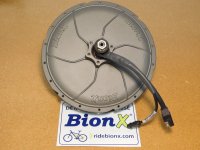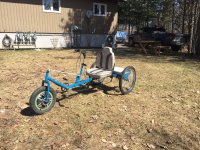1N4001 is absolutely right - you have two (three...) choices:
1) Go with proprietary "BionX" system/parts:
======================================
a) spend a ton more $$ to get a very proprietary and relatively new/fresh BionX 48V battery pack, making absolutely sure that its internal BMS is fully functional.
b) hope to get lucky and get a compatible (BionX OEM) display, wiring, and controls (optional throttle, ebrakes, etc.) without spending even more of your precious $$. The reason I say "lucky" is because you won't be able to easily verify if any of your parts being acquired work as intended until you have them all put together -- and if the system *then* doesn't work, you likely won't have duplicate parts to help you debug the system.
c) search this ES forum for "BionX", and allocate at least 50-100 hours of intense study so that points a) and b) above start making sense to you. During your studies you'll encounter names like "cephalotus" and "syonyk" and others who know way more about this I ever hope to.
2) Convert your newly acquired BionX motor...
=======================================
... into a pretty decent 'generic' direct drive BLDC motor, either using the existing three Hall sensors or not, and either using the built in torque sensor (strain gauge) or not. Unless you have some decent shop skills and tools (like harmonic balance pullers, c-clamps, rubber mallet, etc.), this might amount to something of a challenge in itself, although it is in fact doable. You'll end up opening the motor, removing the internal proprietary BionX controller board, and -- at the very least -- bringing out the three phase wires and connecting them to your (new) external controller, which in this case would need to be able to run the motor in 'sensorless' (i.e., no Halls) mode.
You could of course also bring out five additional wires and utilize the original Hall sensors. Two additional wires are needed to give you access to the single 350 ohm strain gauge glued to the stator shaft on the drive side of the motor. Where and how you pick up and amplify the gauge's output will be its own fun project. If you were to use all of these functions in the motor, you'd be bringing 10 wires out of the motor through a space not designed for that volume. I'm still working on that, so I don't know what to tell you (yet).
Justin (at ebikes.ca) says that this little 350 watt motor, when converted like this, and has Statorade added to help with cooling, makes a pretty decent DD hub motor, and I take him at his word for this.
Optional 3) Cut your losses.
a) use it as a paperweight -- as 14001 says, it's a good looking, newish motor, and the weight is about right to keep most papers from flying away.
b) ???
c) Welcome to ES, everything you need to know is here!





